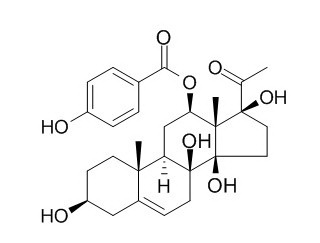Qingyangshengenin
Qingyangshengenin is a a glycoside from the roots of Cynanchum otophyllum.
Inquire / Order:
manager@chemfaces.com
Technical Inquiries:
service@chemfaces.com
Tel:
+86-27-84237783
Fax:
+86-27-84254680
Address:
1 Building, No. 83, CheCheng Rd., Wuhan Economic and Technological Development Zone, Wuhan, Hubei 430056, PRC
Providing storage is as stated on the product vial and the vial is kept tightly sealed, the product can be stored for up to
24 months(2-8C).
Wherever possible, you should prepare and use solutions on the same day. However, if you need to make up stock solutions in advance, we recommend that you store the solution as aliquots in tightly sealed vials at -20C. Generally, these will be useable for up to two weeks. Before use, and prior to opening the vial we recommend that you allow your product to equilibrate to room temperature for at least 1 hour.
Need more advice on solubility, usage and handling? Please email to: service@chemfaces.com
The packaging of the product may have turned upside down during transportation, resulting in the natural compounds adhering to the neck or cap of the vial. take the vial out of its packaging and gently shake to let the compounds fall to the bottom of the vial. for liquid products, centrifuge at 200-500 RPM to gather the liquid at the bottom of the vial. try to avoid loss or contamination during handling.
Chemistr of plant2016, 2016021195
J Biol Chem.2014, 289(3):1723-31
Arch Biochem Biophys.2020, 687:108384.
Korean Herb. Med. Inf.2020, 8(2):233-242.
Environ Toxicol.2022, 37(3):514-526.
Chulalongkorn University2024, 4761190
Plant Physiol.2023, 193(3):1758-1771.
Chemistry of Plant Raw Materials2019, 4:135-147
The Journal of Phytopharmacology2020, 9(1): 1-4
Int Immunopharmacol.2024, 141:112906.
Related and Featured Products
J Asian Nat Prod Res. 2013;15(1):71-7.
Chemical constituents of Arisaema franchetianum tubers.[Pubmed:
23106482]
A novel pyrrolidine alkaloid, (2R*,3S*,5S*)-N,2-dimethyl-3-hydroxy-5-(10-phenyldecyl)pyrrolidine (1), and 17 known compounds were isolated from Arisaema franchetianum Engl. (Araceae) tubers. The 17 compounds were bergenin (2), emodin (3), caffeic acid (4), nobiletin (5), 3-O-β-d-galactopyranosyl-hederagenin 28-O-β-d-xylopyranosyl(1 → 6)-β-d-galactopyranosyl ester (6), coniferin (7), Qingyangshengenin (8), methylconiferin (9), syringaresinol 4'-O-β-d-glucopyranoside (10), gagaminine (11), perlolyrine (12), (S)-1-(1'-hydroxyethyl)-β-carboline (13), 1-(β-carboline-1-yl)-3,4,5-trihydroxy-1-pentanone (14), 1-methoxycarbonyl-β-carboline (15), indolo[2,3-α]carbazole (16), 4-hydroxycinnamic acid methyl ester (17), and methyl 4-[2-hydroxy-2-(4-hydroxy-3-methoxyphenyl)-1-(hydroxymethyl)ethyl] ferulate (18).
METHODS AND RESULTS:
The inhibitory activities of compound 1 and its N-methyl derivative (1a) against porcine respiratory and reproductive syndrome virus (PRRSV), human leukemic K562 cells, and human breast cancer MCF-7 cells were evaluated. Compounds 1 [50% inhibited concentration (IC(50)) = 12.5 ± 0.6 μM] and 1a (IC(50) = 15.7 ± 0.9 μM) were cytotoxic against K562 cells. Compound 1a also had a weak effect on PRRSV with an IC(50) value of 31.9 ± 6.0 μM [selectivity index (SI) = 18.7].
Steroids. 2011 Sep-Oct;76(10-11):1003-9.
Identification of new qingyangshengenin and caudatin glycosides from the roots of Cynanchum otophyllum.[Pubmed:
21513722]
METHODS AND RESULTS:
HPLC analysis of the roots of Cynanchum otophyllum Scheind (Asclepiadaceae) led to the isolation of six new pregnane glycosides, specifically otophyllosides N-P (2-4) and otophyllosides Q-S (7-9), in addition to the identification of three known C-21 steroidal glycosides, otophylloside A (1), otophylloside B (5) and caudatin 3-O-β-D-glucopyranosyl-(1→4)-β-D-oleandropyranosyl-(1→4)-β-D-cymaropyranosyl-(1→4)-β-D-cymaropyranoside (6). The structure of each glycoside was determined by detailed spectroscopic analysis and chemical methods.
CONCLUSIONS:
All compounds contain Qingyangshengenin or caudatin aglycones and a straight sugar chain consisting of 4-7 hexosyl moieties with the mode of 1→4 linkage. The optically isomeric monosaccharides, D- and L-cymarose, coexisted in both otophyllosides R (8) and S (9).



